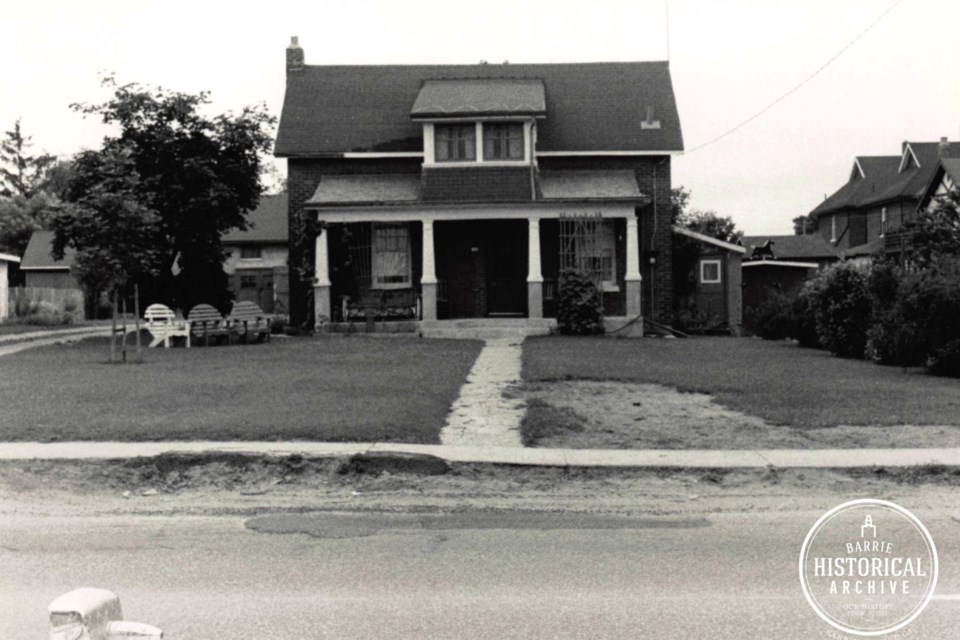This ongoing series from Barrie Historical Archive curator Deb Exel shows old photos from the collection and one from the present day, as well as the story behind them.
202 Bradford St.
In the historic Brock Park neighbourhood, this charming cottage stands out amidst the large two-storey brick homes that line that block on the west side of Bradford Street.
Records indicate that in 1871, possibly earlier, the property belonged to a local blacksmith, William Povey.
Blacksmiths were an important service in pioneer days and they often worked in partnership with wagon and carriage makers. There were several of these businesses in Barrie, the more well-known ones included William Caldwell at 149 Collier St., Sevigny and Cole also on Collier Street and the impressive factory of Barr and Henry at 2 Collier St.
William Povey Sr. bought a blacksmith shop on Collier Street in 1846, quite likely affiliating with Richard and George Whitebread, the carriage makers located at 134 Collier St. It’s just speculation, but a Thomas Summersett, whom Povey thought of as a son according to his will, may have been a foster son or apprentice to William Povey at one time.
Summersett was in the wagon-making business until about 1857, then operated the Allandale axe factory until 1865. Thomas is probably better remembered as the proprietor of the Summersett House hotel on Dunlop Street, near Clapperton Street.
William Povey Sr., was born about 1810 in Devonshire, England, coming to Canada in 1827. His son, William, was born in 1833 in Holland Landing. William’s wife Elizabeth, died after only nine years of marriage, when young William was only seven years old.
Once located in Barrie, one legend depicts Povey as the first to open a blacksmith shop in that part of the province and that his busy smithy was said to employ as many as seven men. He apparently had a reputation as lover of fine horseflesh, owning several good horses himself. His expertise in shoeing race horses was in high demand among the "turf men."
It was his son William and his wife Emma, whom he married in 1862, that owned the Bradford Street property for a period of time.
By about 1901, the property would belong to Archibald Longhurst. Longhurst was born in 1849 in Vaughan Township and later farmed in Innisfil Township – likely where me met Mary Martha Looker, whom he married in 1872. Archie was a butcher in Barrie for 30 years before going into building and cement contracting. The Longhursts had a large family – 15 children in total.
It was Archie’s son Frank and his wife Bertha who lived in the house at 202 Bradford St. for many years. Frank was born in 1885, when his parents lived at 184 Bradford St. As an active young man in 1914, the Baraca class (men’s Bible class) at Collier Street Methodist Church held a fancy dress carnival at the Mammoth Rink – among the prize winners were Clarence Dyment, Charlie Warren, Jack Rodgers and Frank Longhurst.
Two years later, Frank would marry Albertha Pearson, and they would start their life together, raising a family on Bradford Street. Frank, a pipefitter with the CNR, was also recording secretary for Loyal Orange Lodge No. 432 in Allandale.
Apparently Frank contributed much to community life and fun over the years as in the 1970s, he was recognized for exactly this, along with the likes of Gord Roach, Charlie Christie, Hank Partridge, Don Emory, Jim Morley, Ray Gariepy, Pete Sinclair and several others who also had the same claim to fame … or notoriety!
Archibald Longhurst appeared to own other properties in the area as the frame house at 256 Bradford St. was advertised for sale or rent by A. Longhurst in 1926. Perhaps it was because of the property holdings or maybe just for this large, popular family that the creek between John and Brock streets was known as Longhurst Creek.



